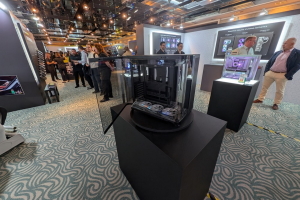Il 'Padrino dell'IA' ha paura della tecnologia e lascia Google: 'Così posso dire quello che penso'

Uno dei pionieri dell'Intelligenza Artificiale ha espresso le sue paure sulla diffusione irresponsabile dell'Intelligenza Artificiale, e per farlo al meglio ha deciso di lasciare Google
di Nino Grasso pubblicata il 02 Maggio 2023, alle 11:31 nel canale WebGeoffrey Hinton è uno dei tre pionieri del mondo dell'Intelligenza Artificiale premiati nel 2018 con il Turing Award, e ha fatto parlare di sé in questi giorni per un'intervista con il New York Times. Qui ha espresso le sue preoccupazioni sui rischi legati all'IA, ed è proprio per divulgare più liberamente il proprio pensiero che Hinton ha di recente lasciato il suo ruolo in Google.

L'accademico ha annunciato le proprie dimensioni ad aprile, mentre lo scorso giovedì ha avuto una discussione con Sundar Pichai di cui non sono stati rivelati ulteriori dettagli: "Mi consolo con la solita scusa: se non l'avessi fatto io qualcun altro lo avrebbe fatto. È difficile capire come si possa impedire di utilizzare l'IA con finalità malevole a chi ha cattive intenzioni", ha dichiarato il settantacinquenne, che ha lavorato per Big G per oltre un decennio.
Il "Padrino dell'IA" lascia Google per parlare liberamente sui suoi rischi
Google aveva ingaggiato Hinton dopo aver acquisito una sua società insieme a due dei suoi studenti, uno dei quali ha poi ottenuto un ruolo rilevante in OpenAI. Il team aveva realizzato una rete neurale capace di identificare oggetti o animali comuni, come cani, gatti, fiori, allenata attraverso l'analisi di migliaia di foto. L'opera di Hinton è stata di fondamentale importanza per progetti come ChatGPT e Google Bard, di cui si parla in maniera massiccia in questi ultimi mesi.
Hinton non aveva mai manifestato preoccupazioni sull'approccio di Google con la tecnologia, almeno fino al rilascio del nuovo Bing con la tecnologia di OpenAI. La strategia di Microsoft è competere con il core business di Google, quello delle ricerche, all'interno di una battaglia che nessuno vuole perdere. Il risultato potrebbe essere un web pieno di un'accozzaglia di testi e immagini non veritieri, con l'utente finale che potrebbe non riuscire più a distinguere "ciò che è vero" da ciò che è falso, ha dichiarato l'accademico.
La diffusione di fake news e contenuti falsi è la preoccupazione più immediata di Hinton, ma nel lungo termine l'IA potrebbe eliminare i lavori meccanici e forse addirittura l'utilità dell'umanità stessa dal momento in cui l'IA inizierà a scrivere, migliorare ed eseguire da sé il proprio codice:
"Poche persone credevano all'idea che questa roba potesse diventare più intelligente delle persone", ha dichiarato Hinton durante l'intervista. "Ma molte persone pensavano che questa realtà fosse ancora lontana. Anche io pensavo avessimo ancora dai 30 ai 50 anni perché si verificasse questa cosa, ma adesso ovviamente non lo penso più".
Hinton ha poi sottolineato su un tweet di non aver lasciato Google affinché potesse criticare l'operato della società, ma di essere uscito dall'azienda in modo da poter "parlare dei pericoli dell'IA liberamente senza considerare l'impatto delle parole su Google". Google ha agito "in maniera molto responsabile", secondo l'accademico, mentre è intervenuto nella discussione per Google anche Jeff Dean che dichiarato che Google ha operato sull'IA con "un approccio responsabile", continuando a "imparare e considerare i rischi" legati alla tecnologia, pur continuando a "innovare coraggiosamente" sulla stessa.










 DJI Mavic 4 Pro: sblocca un nuovo livello per le riprese aeree
DJI Mavic 4 Pro: sblocca un nuovo livello per le riprese aeree Idrogeno verde in Europa: nuovi studi prevedono costi ben superiori alle aspettative
Idrogeno verde in Europa: nuovi studi prevedono costi ben superiori alle aspettative Mario Kart World lancia Switch 2: la magia Nintendo ora in 4K
Mario Kart World lancia Switch 2: la magia Nintendo ora in 4K Scambio di chiavi quantistico via satellite: Colt, Honeywell e Nokia ci provano. Ma ha senso?
Scambio di chiavi quantistico via satellite: Colt, Honeywell e Nokia ci provano. Ma ha senso? HONOR 400 è un successo! Forte slancio nelle vendite con un +400%
HONOR 400 è un successo! Forte slancio nelle vendite con un +400% Redmi Pad 2, i nuovi tablet Xiaomi costano a partire da 200 euro: ecco le novità
Redmi Pad 2, i nuovi tablet Xiaomi costano a partire da 200 euro: ecco le novità All'aeroporto di Fiumicino il più grande sistema di accumulo italiano con batterie EV usate
All'aeroporto di Fiumicino il più grande sistema di accumulo italiano con batterie EV usate HONOR 400 vs HONOR 400 Pro: tutte le differenze, le specifiche e i punti di forza a confronto
HONOR 400 vs HONOR 400 Pro: tutte le differenze, le specifiche e i punti di forza a confronto Nintendo Switch 2 debutta oggi nei negozi! Prezzo e dettagli
Nintendo Switch 2 debutta oggi nei negozi! Prezzo e dettagli Samsung Galaxy S25 Edge è disponibile in Italia! Lo smartphone sottile, potente e intelligente come mai prima
Samsung Galaxy S25 Edge è disponibile in Italia! Lo smartphone sottile, potente e intelligente come mai prima  Nothing presenterà le sue prime cuffie over-ear il prossimo 1° luglio insieme a Phone(3)
Nothing presenterà le sue prime cuffie over-ear il prossimo 1° luglio insieme a Phone(3)  Le nuove soluzioni Lenovo per lo storage e oltre: ThinkAgile, ThinkSystem e gli AI Starter Kit
Le nuove soluzioni Lenovo per lo storage e oltre: ThinkAgile, ThinkSystem e gli AI Starter Kit Netatmo presenta la nuova Stazione Meteo ORIGINAL: aggiornata, potenziata con misurazione pollini e UV
Netatmo presenta la nuova Stazione Meteo ORIGINAL: aggiornata, potenziata con misurazione pollini e UV Cybersecurity: Fortinet rende disponibile Workspace Security Suite e aggiorna FortiDLP
Cybersecurity: Fortinet rende disponibile Workspace Security Suite e aggiorna FortiDLP Netatmo Stazione Meteo ORIGINAL: il ritorno di un’icona, più smart che mai
Netatmo Stazione Meteo ORIGINAL: il ritorno di un’icona, più smart che mai Il meglio dello State of Play, dal nuovo titolo di Suda51 alla collezione più completa di Mortal Kombat
Il meglio dello State of Play, dal nuovo titolo di Suda51 alla collezione più completa di Mortal Kombat Homematic IP: nuova app per ottimizzare i flussi energetici della casa
Homematic IP: nuova app per ottimizzare i flussi energetici della casa



















11 Commenti
Gli autori dei commenti, e non la redazione, sono responsabili dei contenuti da loro inseriti - infoIo immagino che sta storia della IA finirà in modo simile.....
http://karpathy.github.io/2012/10/2...omputer-vision/
questo scriveva poco più di 10 anni fa:
Link ad immagine (click per visualizzarla)
The picture above is funny.
But for me it is also one of those examples that make me sad about the outlook for AI and for Computer Vision. What would it take for a computer to understand this image as you or I do? I challenge you to think explicitly of all the pieces of knowledge that have to fall in place for it to make sense. Here is my short attempt:
You recognize it is an image of a bunch of people and you understand they are in a hallway
You recognize that there are 3 mirrors in the scene so some of those people are “fake” replicas from different viewpoints.
You recognize Obama from the few pixels that make up his face. It helps that he is in his suit and that he is surrounded by other people with suits.
You recognize that there’s a person standing on a scale, even though the scale occupies only very few white pixels that blend with the background. But, you’ve used the person’s pose and knowledge of how people interact with objects to figure it out.
You recognize that Obama has his foot positioned just slightly on top of the scale. Notice the language I’m using: It is in terms of the 3D structure of the scene, not the position of the leg in the 2D coordinate system of the image.
You know how physics works: Obama is leaning in on the scale, which applies a force on it. Scale measures force that is applied on it, that’s how it works => it will over-estimate the weight of the person standing on it.
The person measuring his weight is not aware of Obama doing this. You derive this because you know his pose, you understand that the field of view of a person is finite, and you understand that he is not very likely to sense the slight push of Obama’s foot.
You understand that people are self-conscious about their weight. You also understand that he is reading off the scale measurement, and that shortly the over-estimated weight will confuse him because it will probably be much higher than what he expects. In other words, you reason about implications of the events that are about to unfold seconds after this photo was taken, and especially about the thoughts and how they will develop inside people’s heads. You also reason about what pieces of information are available to people.
There are people in the back who find the person’s imminent confusion funny. In other words you are reasoning about state of mind of people, and their view of the state of mind of another person. That’s getting frighteningly meta.
Finally, the fact that the perpetrator here is the president makes it maybe even a little more funnier. You understand what actions are more or less likely to be undertaken by different people based on their status and identity.
I could go on, but the point here is that you’ve used a HUGE amount of information in that half second when you look at the picture and laugh. Information about the 3D structure of the scene, confounding visual elements like mirrors, identities of people, affordances and how people interact with objects, physics (how a particular instrument works, leaning and what that does), people, their tendency to be insecure about weight, you’ve reasoned about the situation from the point of view of the person on the scale, what he is aware of, what his intents are and what information is available to him, and you’ve reasoned about people reasoning about people. You’ve also thought about the dynamics of the scene and made guesses about how the situation will unfold in the next few seconds visually, how it will unfold in the thoughts of people involved, and you reasoned about how likely or unlikely it is for people of particular identity/status to carry out some action. Somehow all these things come together to “make sense” of the scene.
It is mind-boggling that all of the above inferences unfold from a brief glance at a 2D array of R,G,B values. The core issue is that the pixel values are just a tip of a huge iceberg and deriving the entire shape and size of the icerberg from prior knowledge is the most difficult task ahead of us. How can we even begin to go about writing an algorithm that can reason about the scene like I did? Forget for a moment the inference algorithm that is capable of putting all of this together; How do we even begin to gather data that can support these inferences (for example how a scale works)? How do we go about even giving the computer a chance?
Now consider that the state of the art techniques in Computer Vision are tested on things like Imagenet (task of assigning 1-of-k labels for entire images), or Pascal VOC detection challenge (+ include bounding boxes). There is also quite a bit of work on pose estimation, action recognition, etc., but it is all specific, disconnected, and only half works. I hate to say it but the state of CV and AI is pathetic when we consider the task ahead, and when we think about how we can ever go from here to there. The road ahead is long, uncertain and unclear.
I’ve seen some arguments that all we need is lots more data from images, video, maybe text and run some clever learning algorithm: maybe a better objective function, run SGD, maybe anneal the step size, use adagrad, or slap an L1 here and there and everything will just pop out. If we only had a few more tricks up our sleeves! But to me, examples like this illustrate that we are missing many crucial pieces of the puzzle and that a central problem will be as much about obtaining the right training data in the right form to support these inferences as it will be about making them.
Thinking about the complexity and scale of the problem further, a seemingly inescapable conclusion for me is that we may also need embodiment, and that the only way to build computers that can interpret scenes like we do is to allow them to get exposed to all the years of (structured, temporally coherent) experience we have, ability to interact with the world, and some magical active learning/inference architecture that I can barely even imagine when I think backwards about what it should be capable of.
In any case, we are very, very far and this depresses me. What is the way forward?
---------------------------------------
Lo stesso Karpathy ha ammesso che GPT4 ha superato questo limite.
In un'intervista, Hinton ha dichiarato che la comunità scientifica deve essere attenta a come l'IA viene utilizzata, in particolare nei settori in cui può avere un impatto significativo sulla vita delle persone, come la sicurezza nazionale, la salute e il lavoro.
Uno dei principali problemi che Hinton ha identificato riguarda il fatto che i sistemi di IA possono essere vulnerabili agli attacchi informatici, soprattutto se questi sono progettati per manipolare o ingannare i risultati delle analisi. Hinton ha sottolineato che la sicurezza delle reti di IA deve essere una priorità assoluta per i ricercatori e gli sviluppatori, al fine di proteggere i dati e prevenire possibili attacchi.
Inoltre, Hinton ha esaminato la questione dell'automazione e dell'effetto che potrebbe avere sull'occupazione. Secondo Hinton, l'IA potrebbe portare a un significativo cambiamento nell'ambiente lavorativo, con la possibile eliminazione di molte professioni. È quindi necessario che la società si prepari a gestire questi cambiamenti, adattandosi alle nuove realtà e garantendo che i lavoratori siano formati e dotati delle competenze necessarie per i lavori del futuro.
Inoltre, Hinton ha parlato della questione della responsabilità nella creazione e nell'uso dell'IA. Secondo Hinton, i ricercatori e gli sviluppatori di IA devono essere consapevoli delle possibili conseguenze delle loro creazioni e assumersi la responsabilità delle eventuali conseguenze negative.
Infine, Hinton ha sottolineato l'importanza della regolamentazione e della governance dell'IA, per garantire che questa tecnologia sia utilizzata in modo responsabile e sicuro. Hinton ha dichiarato che gli enti di regolamentazione devono essere in grado di comprendere la tecnologia dell'IA e lavorare insieme ai ricercatori e agli sviluppatori per garantire che gli standard di sicurezza siano rispettati.
In sintesi, Hinton ha messo in guardia sulla necessità di affrontare i possibili rischi dell'IA e di garantire una regolamentazione adeguata per evitare problemi.
sono d'accordo.
Tutti si accuseranno a vicenda di essere dei bot e la confusione sarà totale anche per i moderatori poter capire chi bannare.
A quel punto si valuterà l'inserimento di moderatori controllati dalla AI, essendo gli unici in gradi di poter riconoscere i loro simili.
Ma tutto questo non sarà sufficiente e si dovrà intervenire ad un livello più alto, ovvero a partire dall'amministrazione dei forum, dei server, fino all'intera infrastruttura Internet e non solo, dando alle AI la possibilità di avere tutto sotto il loro controllo, pensando che così si potrà risolvere definitivamente il problema.
Ed invece...diventeremo noi il problema per loro
Devi effettuare il login per poter commentare
Se non sei ancora registrato, puoi farlo attraverso questo form.
Se sei già registrato e loggato nel sito, puoi inserire il tuo commento.
Si tenga presente quanto letto nel regolamento, nel rispetto del "quieto vivere".